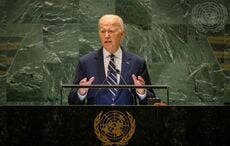Niall O'Dowd: Game plan for a united Ireland: Click here
Photo gallery of the Sinn Fein conference: Click here
When Gerry Adams visited the U.S. in 1994, his visa lasted for 48 hours. It banned him from traveling more than 25 miles outside New York, and it forbade him to raise funds.
Now 15 years later, things couldn’t be more different.
Adams convened a conference on Irish unity in New York’s Hilton hotel on Saturday as part of what he described as “the start of an engagement with the Irish diaspora.” The second conference takes place thousands of miles beyond that 25-mile boundary, in San Francisco.
Hundreds of Irish Americans came to the Hilton, and writers and academics joined Adams on the podium.
“Irish Americans have always been supportive of the different phases and modes of struggle back in Ireland,” Adams said. “Irish America is the most advanced dimension of the diaspora and that’s what this conference is about today – what role people in the U.S. can play, how can they be active, how can they shorten the journey.”
The conference is part of a wider movement towards unity which Sinn Fein launched earlier this year. Adams is sure this can be achieved. “From my perspective, the question is what Irish America can do to help,” Adams said. “It’s not a question of if, it’s how and when.”
Unification would bring economic benefits to the North, Adams argued, saying, “It doesn’t make sense on an island as small as ours not to have a single-island economy.”
Speakers included Brian Keenan, the author and former Lebanon hostage, who talked about growing up in the Protestant community and Brendan O’Leary, the respected political scientist, who has advised the United Nations, and the Iraqi government. O’Leary posed the idea of a federal Ireland made up of two parts to calm the “legitimate concerns of those who fear they’d lose 20 percent of their living standards without British subvention.”
Unification would require big compromises, O’Leary added. “People are woried Ireland would be destabilized and there are fears of costs, of U.K. debt and of replacing U.K. public expenditure.”
Despite these specific questions, the conference was less about practicalities than about dialogue. “We decided very consciously that we wouldn’t come here and tell people what to do,” Adams explained. “We would come here and say, now what do you think you can do.”
Many of those present were from the Ancient Order of Hibernians, the Irish Unity Conference, Irish Northern Aid and other groups, and reactions were positive but realistic.
“It’ll be a difficult path to take,” said Brian Pearson, from County Tyrone. Pearson is a former Long Kesh resident who faced deportation in 1995 but managed to avoid it with the help of Bill Clinton. “The South of Ireland is dormant, they’re not as active as they should be,” he added.
“I think it was very good, very informative,” said Charlie Lord, who emigrated from Belfast in 1987 and lived here illegally before setting up his own business. “We’re looking for a better Ireland for everyone.”
“It’s a great initiative,” said Dr. Christine Kinealy, professor of Irish history at Drew University, noting that the event was open to everyone and there was no screening or ticket requirement, which made it inclusive. “I was disappointed by the lack of women on the panel though,” she said.
At the end of the conference, the precise plans for creating a united Ireland remain unclear, but Sinn Fein’s certainty is not.
“This generation can make it real,” Adams said. “But I can’t tell you how to do it. You know how to do it. and if you don’t, you’ll find out.”




Comments